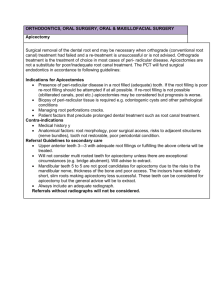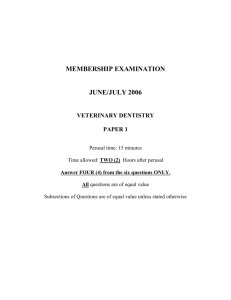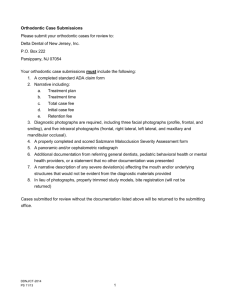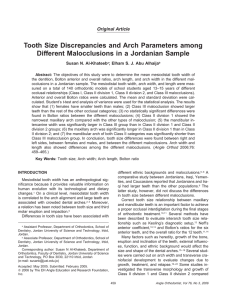lecture 9 model analysis
advertisement
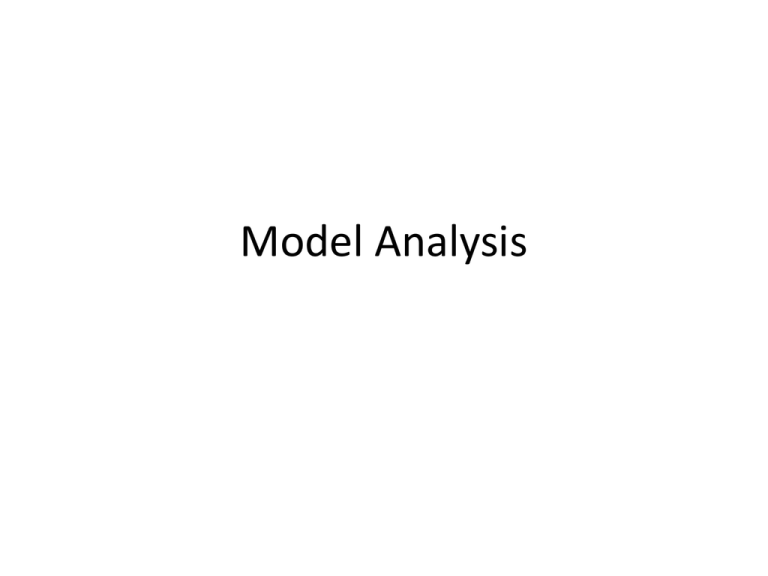
Model Analysis Model analysis Model analysis is the study of maxillary & mandibular dental arches in all three planes of space(sagittal, vertical, transverse planes ) using study models & radiographs which is a valuable tool in orthodontic diagnosis & treatment planning • DIFFERENT IMPORTANT ANALYSIS ARE AS FOLLOWS • CAREY’S ANALYSIS • BOLTON’S ANALYSIS • ASLEY–HOWE ANALYSIS CAREY’S ANALYSIS • The arch-length-tooth material discrepancy--calculated with the help of Carey’s analysis. • It is performed on lower cast. ( same analysis on upper cast is called Arch Perimeter Analysis) PROCEDURE The arch length is measured anterior to the first permanent molar using a soft brass wire. Wire mesial aspect of lower first permanent molar buccal cusps of premolars till incisal edges of the anterior continue upto mesial of the first molar of the contra lateral side. • If anteriors are proclined brass wire should be passed along the cingulum of anterior teeth • If anteriors are retroclined along the labial surface Total tooth material • The mesiodistal width of teeth anterior to first molar are measured & summed up as total tooth material. • The difference between the arch length & the actual measured tooth material gives the discrepancy . • INTERPRETATION If the arch length discrepancy is:• a) 0-2.5mm:- proximal stripping • b) 2.5-5mm:- extraction of second premolar • c) Greater than 5mm:extraction of first premolar WAYNE A. BOLTON ANALYSIS • Bolton pointed out that the extraction of one tooth or several teeth should be done according to the ratio of tooth material between the maxillary & mandibular arch to get ideal interdigitation, overjet, overbite & alignment of teeth to attain an optimum interarch relationship • Bolton’s analysis helps to determine the disproportion between the size of maxillary & mandibular teeth PROCEDURE • The sum of mesiodistal diameter of the12 maxillary teeth & the sum of the mesiodistal diameter of the 12mandibular teeth are determined • In same manner the sum of 6 maxillary anterior teeth & the sum of 6 mandibular teeth is determined. • OVERALL RATIO:sum of mesiodistal width of mandibular 12 teeth sum of mesiodistal width of maxillary 12 teeth X 100 = 91.3% ANTERIOR RATIO:sum of mesiodistal width of mandibular 6 teeth sum of mesiodistal width of maxillary 6 teeth MEAN X 100 = 77.2% • INFERENCES: • -If the ratio is more than mean value, then the mandibular tooth material is excessive. • If the ratio is less than mean value, then the maxillary tooth material is excessive. • Bolton prefers to do proximal stripping on the upper arch if the upper anterior tooth material is in excess & extraction of lower incisor, if necessary to reduce tooth material in the lower arch • Overall ratio• Maxillary excess = maxillary 12 Mandibular excess = • Mandibular 12 mandibular 12 X 100 91.3 maxillary 12 X 91.3 100 • Anterior ratio • • Maxillary anterior excess= maxillary 6 • • Mandibular anterior excess = mandibular 6 mandibular 6 X 100 77.2 maxillary 6 X 77.2 100 ASHLEY HOWE’S ANALYSIS • He considered tooth crowding to be due to deficiency in arch width rather than arch length. • PROCEDURE TTM- (Total Tooth Material ) • Refers to sum of the mesiodistal width of the teeth from first molar to first molar PMD- (Premolar Diameter ) • PMD- (Premolar Diameter ) Arch width measured from the buccal cusp tips of the first premolar on one side to the buccal cusp tip on other side PMBAW (Premolar basal ach Width) • PMBAW (Premolar basal ach Width) From canine fossa of one side to the other gives the width of dental arch at the apical base or the junction between the basal bone and the alveolar process. If canine fossae is not clearly distinguishable the measurement is made from a point that is 8 mm below the crest of the inter dental papilla distal to the canine. • The PMBAW and PMD are compared. • If PMBAW is greater than PMD ---- arch expansion is possible. • If PMBAW is less than PMD--- arch expansion is not possible. • According to Ashley Howe, to achieve normal occlusion with a full complement of teeth the basal arch width at the premolar region should be 44% the sum of mesiodistal widths of all the teeth mesial to the second permanent molar. • This ratio (expressed as %) between the apical base width at the premolar region and the total tooth material is called the premolar basal arch width percentage. • PMBAW is determined by using the formula: • P.M. B.A.W. % = P.M. B.A.W. X 100 T.T.M. INFERENCES • If PMBAW > PMD :-indication that basal arch is sufficient to allow expansion of premolars • If PMD > PMBAW :• Can be three possibilities • 1) contraindicated for expansion • 2) move teeth distally • 3) Extract some teeth • • • • If PMBAW X100 / TTM ) A) less than 37% or less -require extraction B) if 44% or more - extraction not required c) if between 37-44% (border line case) may or may not require extraction

